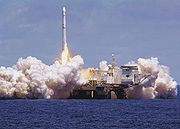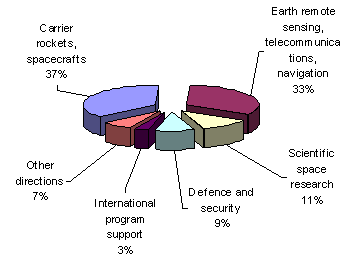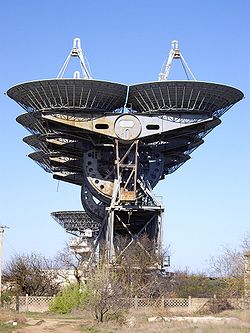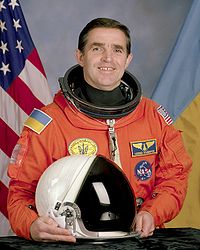
National Space Agency of Ukraine
Encyclopedia
The State Space Agency of Ukraine (SSAU; , Derzhavne kosmichne ahentstvo Ukrayiny, ДКАУ, DKAU) is the Ukrainian government
agency responsible for space policy and programs.
The former name (before December 9, 2010) - Національне космічне агентство України, НКАУ (the National Space Agency of Ukraine, NSAU
NSAU is a civil body in charge of co-ordinating the efforts of government installations, research, and industrial companies (mostly state-owned). Several space-related institutes and industries are directly subordinated to NSAU. However, it is not a united and centralized system immediately participating in all stages and details of space programs (like NASA
in the United States
). A special space force in the military of Ukraine is also absent.
The agency oversees launch vehicle and satellite
programs, co-operative programs with the Russian Aviation and Space Agency, the European Space Agency
, NASA
, and commercial ventures. International participation includes Sea Launch
and the Galileo positioning system
.
Launches are conducted at Kazakhstan
's Baikonur
, Russia
's Plesetsk Cosmodrome
s, Alcântara Launch Center (Brazil
), and on Sea Launch
's floating platform. NSAU has ground control and tracking facilities in Yevpatoria, Crimea
, while the control-measuring complexes are located in Yevpatoria and Dunaivtsi
(Khmelnytskyi Oblast
).
Ukrainian spacecraft includes few kinds for own and foreign use and international cooperation. Ukraine has supplied Russia with military satellites and their launch vehicles, a unique relationship in the world.
Ukraine became the tenth space power (country able to launch own satellite by own launcher) in 31 August 1995 (at start of Sich-1 on Tsyklon).
As of April 2009 the Ukrainian National Space Agency is planning to launch a Ukrainian communications satellite
by September 2011 and a Sich-2 before the end of 2011.

 Space activities in Ukraine have been pursued over a 10-year span in strict accordance with National Space Programs. Each of them was intended to address the relevant current issues to preserve and further develop the space potential of Ukraine.
Space activities in Ukraine have been pursued over a 10-year span in strict accordance with National Space Programs. Each of them was intended to address the relevant current issues to preserve and further develop the space potential of Ukraine.
The First Program (1993–1997) was called upon to keep up the research and industrial space-related potentiality for the benefit of the national economy and state security as well as to be able to break into the international market of space services. The Second Program (1998–2002) was aimed at creating an internal market of space services, conquering the international space markets by presenting in-house products and services (including launch complexes and spacecraft, space-acquired data, space system components) and integrating Ukraine into the worldwide space community.
The National Space Program of Ukraine for 2003-2007 (NSPU), which was adopted by the Verkhovna Rada of Ukraine (the Parliament of Ukraine) on October 24, 2002, outlines the main goals, assignments, priorities, and methods of maintaining space activity in Ukraine.
The Ukrainian Cabinet of Ministers announced its plans on 13 April 2007 to allocate 312 million euros to the National Space Program for 2007-2011.
Specific programs
Goals of the program
 Most of the enterprises are located in Dnipropetrovsk
Most of the enterprises are located in Dnipropetrovsk
or Kiev
Dnipropetrovsk
Kiev
Kharkiv
Crimea
 During 1991-2007, a total of 97 launches of Ukrainian LV were conducted, including, but not limited to launches on the Sea Launch mobile launch pad. In 2006 Ukrainian launch vehicles accounted for 12.1% of all launches into space in the world.
During 1991-2007, a total of 97 launches of Ukrainian LV were conducted, including, but not limited to launches on the Sea Launch mobile launch pad. In 2006 Ukrainian launch vehicles accounted for 12.1% of all launches into space in the world.
Ukrainian companies Yangel Yuzhnoye State Design Office and Makarov Yuzhny Machine-Building Plant (Yuzhmash) have engineered and produced seven types of launch vehicles. Adding strapon boosters to launch vehicles may expand the family of Mayak, which is the latest launch vehicle developed.
and Okean Earth observation satellite
s, few other types of satellites and the Coronas solar observatory in cooperation with Russia.
For own use NSAU has engineered, constructed and launched a total of 6 satellites (since 1992). The latest Ukrainian satellite, Sich-1M, was launched in 2004 and was a successful mission. The launch of Sich-2 was scheduled in 2007 with a goal of scientific research and space exploration; it was launched in August 2011. NSAU is currently working on further Sich series satellites: Sich-3, Sich-3-O and Sich-3-P; and a "lunar" satellite to fly around the Moon
in 2017.
 Prior to Ukraine's independence, several Ukrainians flew in space under the Soviet flag. The first Ukrainian to fly in space under the Ukrainian flag was Leonid K. Kadenyuk on 13 May 1997. He was a payload specialist
Prior to Ukraine's independence, several Ukrainians flew in space under the Soviet flag. The first Ukrainian to fly in space under the Ukrainian flag was Leonid K. Kadenyuk on 13 May 1997. He was a payload specialist
on NASA's STS-87
Space Shuttle mission. It was an international spaceflight mission, involving crew members from NASA
(USA), NSAU (Ukraine) and NASDA (Japan).
Sea Launch is joint venture space transportation company, partially owned by companies in Ukraine which handle operations for the National Space Agency. Sea Launch offers a mobile sea platform, used for spacecraft launches of commercial payloads on specialized Ukrainian Zenit 3SL rockets. The main advantage of the floating cosmodrome is its placing directly on the equator. It allows taking greatest advantage of Earth's rotation for delivering payloads into orbit at low expense.
Within the framework of the project the space rocket complex was developed, which consists of four components:
The aircraft is equipped with special devices to secure the LV above the fuselage. The operators and onboard equipment are located in the pressure-tight cabins. The Svityaz LV is being created on the basis of units, aggregates and systems of Zenit LV. It consists of three stages of non-toxic propellants - liquid oxygen and kerosene. The launch vehicle is injected into the geostationary orbit using a solid-propellant apogee stage.
Government of Ukraine
Government of Ukraine is often associated with the Cabinet of Ministers of Ukraine. However it should be considered that Ukraine is a country under a semi-presidential system with separate legislative, executive, and judicial branches of government...
agency responsible for space policy and programs.
The former name (before December 9, 2010) - Національне космічне агентство України, НКАУ (the National Space Agency of Ukraine, NSAU
NSAU is a civil body in charge of co-ordinating the efforts of government installations, research, and industrial companies (mostly state-owned). Several space-related institutes and industries are directly subordinated to NSAU. However, it is not a united and centralized system immediately participating in all stages and details of space programs (like NASA
NASA
The National Aeronautics and Space Administration is the agency of the United States government that is responsible for the nation's civilian space program and for aeronautics and aerospace research...
in the United States
United States
The United States of America is a federal constitutional republic comprising fifty states and a federal district...
). A special space force in the military of Ukraine is also absent.
The agency oversees launch vehicle and satellite
Satellite
In the context of spaceflight, a satellite is an object which has been placed into orbit by human endeavour. Such objects are sometimes called artificial satellites to distinguish them from natural satellites such as the Moon....
programs, co-operative programs with the Russian Aviation and Space Agency, the European Space Agency
European Space Agency
The European Space Agency , established in 1975, is an intergovernmental organisation dedicated to the exploration of space, currently with 18 member states...
, NASA
NASA
The National Aeronautics and Space Administration is the agency of the United States government that is responsible for the nation's civilian space program and for aeronautics and aerospace research...
, and commercial ventures. International participation includes Sea Launch
Sea Launch
Sea Launch is a spacecraft launch service that uses a mobile sea platform for equatorial launches of commercial payloads on specialized Zenit 3SL rockets...
and the Galileo positioning system
Galileo positioning system
Galileo is a global navigation satellite system currently being built by the European Union and European Space Agency . The €20 billion project is named after the famous Italian astronomer Galileo Galilei...
.
Launches are conducted at Kazakhstan
Kazakhstan
Kazakhstan , officially the Republic of Kazakhstan, is a transcontinental country in Central Asia and Eastern Europe. Ranked as the ninth largest country in the world, it is also the world's largest landlocked country; its territory of is greater than Western Europe...
's Baikonur
Baikonur Cosmodrome
The Baikonur Cosmodrome , also called Tyuratam, is the world's first and largest operational space launch facility. It is located in the desert steppe of Kazakhstan, about east of the Aral Sea, north of the Syr Darya river, near Tyuratam railway station, at 90 meters above sea level...
, Russia
Russia
Russia or , officially known as both Russia and the Russian Federation , is a country in northern Eurasia. It is a federal semi-presidential republic, comprising 83 federal subjects...
's Plesetsk Cosmodrome
Plesetsk Cosmodrome
Plesetsk Cosmodrome is a Russian spaceport, located in Arkhangelsk Oblast, about 800 km north of Moscow and approximately 200 km south of Arkhangelsk.-Overview:...
s, Alcântara Launch Center (Brazil
Brazil
Brazil , officially the Federative Republic of Brazil , is the largest country in South America. It is the world's fifth largest country, both by geographical area and by population with over 192 million people...
), and on Sea Launch
Sea Launch
Sea Launch is a spacecraft launch service that uses a mobile sea platform for equatorial launches of commercial payloads on specialized Zenit 3SL rockets...
's floating platform. NSAU has ground control and tracking facilities in Yevpatoria, Crimea
Crimea
Crimea , or the Autonomous Republic of Crimea , is a sub-national unit, an autonomous republic, of Ukraine. It is located on the northern coast of the Black Sea, occupying a peninsula of the same name...
, while the control-measuring complexes are located in Yevpatoria and Dunaivtsi
Dunaivtsi
Dunaivtsi is the capital city of Dunaivtsi Raion, Khmelnytskyi Oblast , Ukraine. The city is located on the river Ternavka, 22 km away from the railway station Dunaivtsi and 68 km from the Khmelnytskyi. Population is 16,448...
(Khmelnytskyi Oblast
Khmelnytskyi Oblast
Khmelnytskyi Oblast is an oblast of western Ukraine. The administrative center of the oblast is the city of Khmelnytskyi.The current estimated population is around 1,401,140 .-Geography:...
).
Ukrainian spacecraft includes few kinds for own and foreign use and international cooperation. Ukraine has supplied Russia with military satellites and their launch vehicles, a unique relationship in the world.
Ukraine became the tenth space power (country able to launch own satellite by own launcher) in 31 August 1995 (at start of Sich-1 on Tsyklon).
As of April 2009 the Ukrainian National Space Agency is planning to launch a Ukrainian communications satellite
Communications satellite
A communications satellite is an artificial satellite stationed in space for the purpose of telecommunications...
by September 2011 and a Sich-2 before the end of 2011.
Main tasks
- Development of state policy concepts in the sphere of research and peaceful uses of space, as well as in the interests of national security;
- Organization and development of space activities in Ukraine and under its jurisdiction abroad;
- Contributing to state national security and defense capability;
- Organization and development of Ukraine’s cooperation with other states and international space organizations.
Space program


The First Program (1993–1997) was called upon to keep up the research and industrial space-related potentiality for the benefit of the national economy and state security as well as to be able to break into the international market of space services. The Second Program (1998–2002) was aimed at creating an internal market of space services, conquering the international space markets by presenting in-house products and services (including launch complexes and spacecraft, space-acquired data, space system components) and integrating Ukraine into the worldwide space community.
The National Space Program of Ukraine for 2003-2007 (NSPU), which was adopted by the Verkhovna Rada of Ukraine (the Parliament of Ukraine) on October 24, 2002, outlines the main goals, assignments, priorities, and methods of maintaining space activity in Ukraine.
The Ukrainian Cabinet of Ministers announced its plans on 13 April 2007 to allocate 312 million euros to the National Space Program for 2007-2011.
Specific programs
- Scientific space research
- Remote sensing of the Earth
- Satellite telecommunication systems
- Development of ground-based infrastructure for navigation and special information system
- Space activities in the interests of national security and defense
- Space complexes
- Development of base elements and advanced space technologies
- Development of research, test and production base of the space sector
Goals of the program
- To develop a national system for Earth observation from outer space to meet the national demands in the social economic sphere and for security and defense purposes
- To introduce satellite systems and communication facilities into the telecommunication infrastructure of the state
- To obtain new fundamental knowledge on near-Earth outer space, the solar system, deep space, biological and physical processes and the microgravity condition
- To create and develop techniques for space access with a view toward realizing national and international projects and to enable the home-made rocket to be employed on the worldwide market of space transportation services
- To elaborate the advanced space facilities
- To ensure the innovative development of the space sector in terms of improving its research, experimental and production basis
National enterprises of space industry

Dnipropetrovsk
Dnipropetrovsk or Dnepropetrovsk formerly Yekaterinoslav is Ukraine's third largest city with one million inhabitants. It is located southeast of Ukraine's capital Kiev on the Dnieper River, in the south-central region of the country...
or Kiev
Kiev
Kiev or Kyiv is the capital and the largest city of Ukraine, located in the north central part of the country on the Dnieper River. The population as of the 2001 census was 2,611,300. However, higher numbers have been cited in the press....
Dnipropetrovsk
- State Enterprise Makarov Yuzhny Machine-Building Plant (Yuzhmash)
- State Enterprise Yangel Yuzhnoye State Design Office
- State Enterprise "Dniprokosmos"
- State Enterprise "Dniprovsky Project Institute"
- Makarov National Center of aero-cosmic education for the youth
- State Enterprise "Center of rocket-space technology standardization"
- State Enterprise "Nikopol Pipe Plant"
- State Enterprise "PavlohradPavlohradPavlohrad or Pavlograd is an indistrial city in eastern Ukraine, located within the Dnipropetrovs'ka oblast, and had a population of 118,800 in 2001. The rivers of Vovcha , Hnizdka , Kocherha flow through Pavlohrad. The area of the city is . There are 20 schools and 1 lyceum in the city.In 1930...
Chemical Plant"
Kiev
- State Enterprise "Arsenal Factory"
- State Enterprise "Ukrkosmos"
- State Enterprise "Kyivprylad"
- State Enterprise "Scientific Center of a Precise Machine-building"
- State Joint-Stock Holding Company "Kiev Radio Plant" (former Production Complex)
- Open Joint-Stock Association "Kiev Radio Plant"
- Open Joint-Stock Association "RSB-Radio Plant"
- Open Joint-Stock Association "SPC Kurs"
- State Scientific-Production Center "Pryroda"
- State Scientific-Production Enterprise "Ukrainski innovatsiyni promyslovi tekhnolohii"
Kharkiv
- Science-research technological institute of instrument-building (NDTIP)
Crimea
- National Space Facilities Control and Testing Center
Ukrainian launch vehicles

Ukrainian companies Yangel Yuzhnoye State Design Office and Makarov Yuzhny Machine-Building Plant (Yuzhmash) have engineered and produced seven types of launch vehicles. Adding strapon boosters to launch vehicles may expand the family of Mayak, which is the latest launch vehicle developed.
- TsyklonTsyklonThe Tsyklon , GRAU index 11K67, was a Soviet/Ukrainian-designed expendable launch system, primarily used to put Cosmos satellites into low Earth orbit. It is based on the R-36 intercontinental ballistic missile designed by Mikhail Yangel and made eight launches, with seven successes, and one failure...
- Tsyklon-2Tsyklon-2The Tsyklon-2, also known as Tsiklon-2 and Tsyklon-M, GRAU index 11K69, was a Soviet, and subsequently Ukrainian orbital carrier rocket. A derivative of the R-36 ICBM, and a member of the Tsyklon family, it made its maiden flight on 6 August 1969, and after 106 launches, made its final flight on 24...
- Tsyklon-3Tsyklon-3The Tsyklon-3, also known as Tsiklon-3, GRAU index 11K68, was a Soviet, and subsequently Ukrainian orbital carrier rocket. A derivative of the R-36 ICBM, and a member of the Tsyklon family, it made its maiden flight on 24 June 1977, and was retired on 30 January 2009...
- Zenit 2
- Zenit-3SLZenit-3SLThe Zenit-3SL is an expendable carrier rocket operated by Sea Launch. First flown in 1999, it has been launched 30 times, with two failures and one partial failure. It is a member of the Zenit family of rockets, and is built by the Yuzhnoye Design Bureau. RKK Energia produces the Block DM-SL upper...
- Dnepr-1
- Mayak
Ukrainian satellites
Ukraine produced the SichSich-1
Sich-1 is first Ukrainian Earth observation satellite....
and Okean Earth observation satellite
Earth observation satellite
Earth observation satellites are satellites specifically designed to observe Earth from orbit, similar to reconnaissance satellites but intended for non-military uses such as environmental monitoring, meteorology, map making etc....
s, few other types of satellites and the Coronas solar observatory in cooperation with Russia.
For own use NSAU has engineered, constructed and launched a total of 6 satellites (since 1992). The latest Ukrainian satellite, Sich-1M, was launched in 2004 and was a successful mission. The launch of Sich-2 was scheduled in 2007 with a goal of scientific research and space exploration; it was launched in August 2011. NSAU is currently working on further Sich series satellites: Sich-3, Sich-3-O and Sich-3-P; and a "lunar" satellite to fly around the Moon
Moon
The Moon is Earth's only known natural satellite,There are a number of near-Earth asteroids including 3753 Cruithne that are co-orbital with Earth: their orbits bring them close to Earth for periods of time but then alter in the long term . These are quasi-satellites and not true moons. For more...
in 2017.
Human flights

Payload Specialist
A Payload Specialist ' was an individual selected and trained by commercial or research organizations for flights of a specific payload on a NASA Space Shuttle mission...
on NASA's STS-87
STS-87
STS-87 was a Space Shuttle mission launched from KSC pad 39-B on 19 November 1997. It was the 88th flight of the Space Shuttle, and the 24th flight of Columbia...
Space Shuttle mission. It was an international spaceflight mission, involving crew members from NASA
NASA
The National Aeronautics and Space Administration is the agency of the United States government that is responsible for the nation's civilian space program and for aeronautics and aerospace research...
(USA), NSAU (Ukraine) and NASDA (Japan).
Sea Launch project
- See more detailed article at Sea LaunchSea LaunchSea Launch is a spacecraft launch service that uses a mobile sea platform for equatorial launches of commercial payloads on specialized Zenit 3SL rockets...
Sea Launch is joint venture space transportation company, partially owned by companies in Ukraine which handle operations for the National Space Agency. Sea Launch offers a mobile sea platform, used for spacecraft launches of commercial payloads on specialized Ukrainian Zenit 3SL rockets. The main advantage of the floating cosmodrome is its placing directly on the equator. It allows taking greatest advantage of Earth's rotation for delivering payloads into orbit at low expense.
Within the framework of the project the space rocket complex was developed, which consists of four components:
- marine segment
- rocket segment
- spacecraft segment and
- facilities
Svityaz project
The Svityaz aerospace rocket complex (ASRC) is intended for launching of various spacecraft (SC) into circular, elliptic and high-altitude circular, including the geostationary (GSO), orbits. Svityaz ASC represents a unique system that allows launch of spacecraft without utilization of complicated ground infrastructure. The Svityaz is launched directly from a modified version of Mriya, a Ukrainian airplane and airplane carrier that is currently the largest one in the world. Modified Mriya that will be used to carry Svityaz has been designated a code of An-225-100.The aircraft is equipped with special devices to secure the LV above the fuselage. The operators and onboard equipment are located in the pressure-tight cabins. The Svityaz LV is being created on the basis of units, aggregates and systems of Zenit LV. It consists of three stages of non-toxic propellants - liquid oxygen and kerosene. The launch vehicle is injected into the geostationary orbit using a solid-propellant apogee stage.
See also
- Lviv Centre of Institute for Space ResearchLviv Centre of Institute for Space ResearchThe Lviv Centre of Institute of Space Research of the National Academy of Sciences of Ukraine and National Space Agency of Ukraine was formed in 1996 at the basis of Special Design Bureau of Karpenko Institute for Physics and Mechanics of NASU as a scientific experimental division of Institute...
- A Message From EarthA Message From EarthA Message from Earth is a high-powered digital radio signal that was sent on 9 October 2008 towards Gliese 581 c, a large terrestrial extrasolar planet orbiting the red dwarf star Gliese 581. The signal is a digital time capsule containing 501 messages that were selected through a competition on...
- A Message from Earth (AMFE) was sent by NSAU towards Gliese 581 c, a large terrestrial extrasolar planet orbiting the red dwarf star Gliese 581. The signal is a digital time capsule containing 501 messages.
External links
- English-language home page
- Ukrainian space history on Astronautix.com encyclopedia
- Ukraine's Space Program - article in Moscow Defense Brief
- NASA, Ukraine Prepare Flights to Moon, RedNova News
- Ukrainian Rockets to Orbit U.S. Satellites, Novosti
- Yuzhnoe SDO, major Ukrainian Space Technologies Design Bureau

